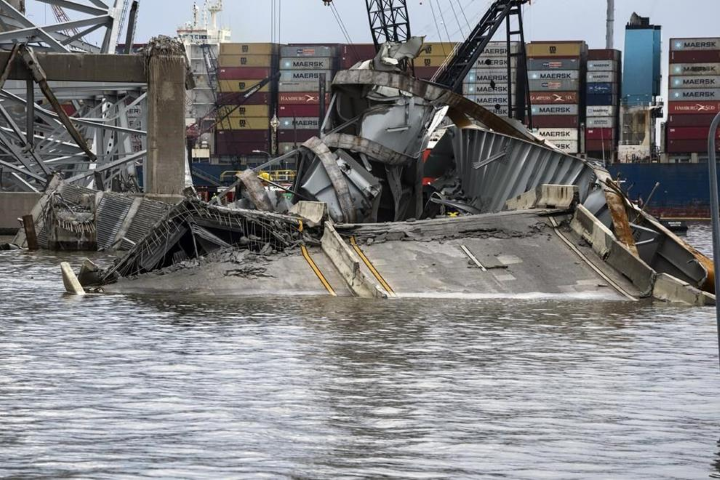
The site of the collapsed Francis Scott Key Bridge and the container ship that toppled it, Dali, are seen from the debris retrieval vessel Reynolds, April 4, 2024, in Baltimore. (Kaitlin Newman/The Baltimore Banner via AP)
Salvage operations began on Sunday to clear containers from the cargo ship that collided with and caused the collapse of Baltimore's Francis Scott Key Bridge. This marks a crucial step in reopening the affected shipping lane, a vital artery for maritime traffic in the United States.
According to a statement from the Key Bridge Response Unified Command, the process of removing containers from the Dali's deck commenced on Sunday and will continue throughout the week, weather permitting. Crews are also working towards dismantling sections of the bridge that rest atop the ship's bow, ultimately aiming to facilitate its movement.
Authorities reported that a total of 32 vessels have navigated through temporary channels established on both sides of the wreckage.
U.S. Coast Guard Captain David O’Connell, part of the Unified Command, emphasized the simultaneous efforts to clear enough debris to accommodate larger commercial vessels. These efforts are crucial for the full resumption of maritime traffic along the affected route.
The Dali has been ensnared beneath twisted metal in the Patapsco River since the collision on March 26, a tragic incident that resulted in the deaths of six workers.
President Joe Biden conducted an aerial survey of the damaged bridge on Friday, witnessing firsthand the extensive damage and the extensive salvage operation in progress. He also spent over an hour meeting with the families of the deceased workers, offering his condolences and support.
The incident occurred while eight workers, hailing from Mexico, Guatemala, Honduras, and El Salvador, were repairing potholes on the bridge during the early hours of the morning. Two individuals were rescued from the wreckage, while the bodies of three others were recovered in the following days. The search for the remaining victims is ongoing.
To facilitate debris removal, authorities have established an alternative channel for vessels involved in the cleanup efforts. The Army Corps of Engineers aims to establish a restricted-access channel by the end of April, allowing passage for container ships and select vessels transporting automobiles and agricultural machinery. Normal port operations in Baltimore are expected to resume by May 31, according to the White House.
Over 50 salvage divers and a dozen cranes are deployed at the site to assist in cutting out sections of the collapsed bridge and removing them from the waterway. This comprehensive effort underscores the urgency and complexity of the operation to restore maritime traffic and ensure the safety of the water route.















